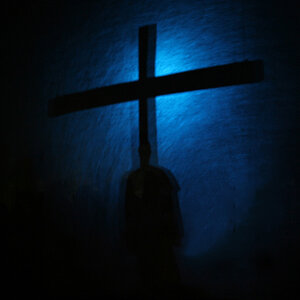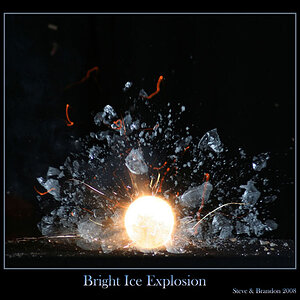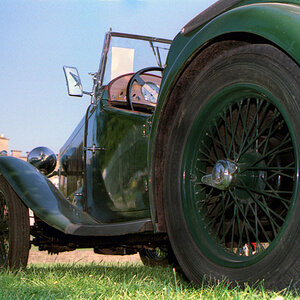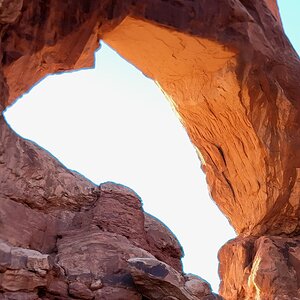Alpha
Troll Extraordinaire
- Joined
- Mar 15, 2005
- Messages
- 5,451
- Reaction score
- 41
- Location
- San Francisco
- Can others edit my Photos
- Photos NOT OK to edit
I do most of my work with what's often referred to as a digital darkroom, though I use film, not digital cameras.
First rule of digital darkroom: You have a lot of work ahead of you before you can attempt to scan, edit, or print anything.
Your digital darkroom will consist usually of no more than four or five components: A computer, a monitor, a film scanner, a flatbed scanner, and a printer or two.
Computers:
If you can help it, your computer should have at least 1gig of ram, and the biggest hard drive you can reasonably afford. Partition your hard drive to separate operating system files from data. You want to keep the file structure clean and well organized. Your image editing software will pull on a lot of scratch space for editing.
Monitors:
Graphic heads will tell you that CRT is the only way to go for true color accuracy. This is probably true. However, with proper calibration, you can achieve very good results with an LCD display.
Film Scanners:
In my experience, Nikon makes the best film scanners, with Minolta taking second. Do yourself a favor and stay away from Polarioid scanners, as they invariably have problems loading and unloading film trays. That may not affect the scan itself, but it's a real nuisance. I personally work with a Nikon Super Coolscan 9000, and it's absolutely wonderful, but it's very expensive.
Flatbed Scanners:
If you can afford it, shell out for a film scanner instead of trying to scan your negatives with a flatbed. The difference is enormous. You may have prints to scan, that you'll need to use a flatbed for. In my opinion, Epson probably makes the best flatbed scanners. HP's are decent.
Printers:
Printers are absolutely key! No matter how great your image looks on screen, not being able to accurately print it is extremely dissapointing and frustrating. Laser printers are an absolute no-no. Not all inkjet printers are created equal. There are two different kinds of inkjets, utilizing two completely different kinds of ink. Most lower-end consumer inkjets use what's called dye-based ink. Dye-based ink systems basically attempt to saturate the paper with ink. The color accuracy is not as good, and the prints will not last that long. The preferred type of inkjet uses what's called pigment-based ink. This type of ink is slightly drier, if you will, than dye-based ink. Pigment based inkjets basically layer the ink on top of the paper instead of trying to embed it into the paper. Brand selection is very important when choosing an inkjet. Epson and HP are the top brands, and i've done extensive work with both. I can honestly tell you that Epson is without a doubt the way to go. The inks are better, the color accuracy is better, and the metamerism is better. My personal printer of choice is the Epson 2200/2100. I've worked with some very expensive pigment-based HP printers, and they're an absolute nightmare to calibrate, even using expensive proprietary RIP's (raster image processors).
Before you can actually start using any of your equipment, it's absolutely essential that you calibrate all of it. The object is to have an identical image throughout the entire workflow. I.e. your scanned image is just like the negative because your scanner and monitor are calibrated, and your printer outputs an image identical to what's on your screen. Getting started, the first thing you'll need to do is calibrate your monitor. My software of choice is Monaco Optix XR, though there are good calibrating packages out there that are more cost effective. Once you've calibrated your monitor, then you can go about calibrating the other devices. My software of choice here is again made by Monaco, and it's called EZColor. The device calibration/profiling software will basically allow you to create custom color profiles for your scanners and printers so that the image is consistent throughout the workflow.
Scanning:
Scan your images as raw TIFF's. That means no color or focus correction is performed by the scanner. DPI quality is always a big question. You can scan at whatever resolution you like, but my general rule of thumb is that because the native resolution of film is somewhere around 3000dpi, you should try to scan at around 3000dpi. Here i'll refer back to the giant hard drive, as I commonly have 6x7 color positive scans that exceed 500mb.
Processing:
Do your processing work in RGB mode, not CMYK. Most big, beefy inkjets print in a variation of CMYK. The Epson 2200, for example, prints in CCMMYKK, a 7-color variation on CMYK. It would seem intuitive that when working with a CMYK or a CMYK-variant printer, you should process and print in CMYK mode. Not true (Unless you're using a RIP). While the printers are built to print in CMYK mode, they aren't built to interpret CMYK images for some reason. Therefore, if you try to print a CMYK image, your printer will either refuse, or it will convert the image from CMYK to RGB, and then from RGB to CMYK (or in my case CCMMYKK). That's bad.
Printing:
Color and B&W inkjet printing are completely different ball games. Choose your paper wisely. Some papers are made especially for Dye-based printers, some are made especially for Pigment-based. Epson makes good paper, Ilford's paper is better. I won't do any explaining about color printing because it's not difficult to get great results with proper calibration.
B&W printing can be very difficult to get right. Your two biggest problems are going to be dot count and metamerism. Metamerism is the quality of an image changing color depending on what light it's in. It's not uncommon for B&W images to appear green or magenta depending on what kind of light they're in. In my honest opinion, entirely eliminating metamerism with a stock inkjet is nearly impossible. The only practical solution is to keep the images under "cool" light for viewing (i.e. flourescent or low voltage incandescent). In terms of actual image accuracy, you may have to toy with the dot count (ink output) on your printer, as they often will lay down too much ink (though sometimes not enough). My best advice is to toy around with your color profiles and printer settings. Eventually you'll find an acceptable combination. If you're serious about B&W inkjet printing, you'd be doing yourself a disservice is you didn't look into a black-only ink system. This means having a dedicated black and white printer, that will use between four and seven different shades of black ink. The results are absolutely unbeatable in the inkjet world, though it can become very pricey if you're doing high volumes of printing. I'm personally a fan of the Piezography systems, but there are a number of other good black-only systems that may be more cost-effective.
Well all in all, I hope that this guide will prove useful to anyone trying to setup their own "digital darkroom." Good luck and feel free to get in touch with me if anyone has any more specific questions.
First rule of digital darkroom: You have a lot of work ahead of you before you can attempt to scan, edit, or print anything.
Your digital darkroom will consist usually of no more than four or five components: A computer, a monitor, a film scanner, a flatbed scanner, and a printer or two.
Computers:
If you can help it, your computer should have at least 1gig of ram, and the biggest hard drive you can reasonably afford. Partition your hard drive to separate operating system files from data. You want to keep the file structure clean and well organized. Your image editing software will pull on a lot of scratch space for editing.
Monitors:
Graphic heads will tell you that CRT is the only way to go for true color accuracy. This is probably true. However, with proper calibration, you can achieve very good results with an LCD display.
Film Scanners:
In my experience, Nikon makes the best film scanners, with Minolta taking second. Do yourself a favor and stay away from Polarioid scanners, as they invariably have problems loading and unloading film trays. That may not affect the scan itself, but it's a real nuisance. I personally work with a Nikon Super Coolscan 9000, and it's absolutely wonderful, but it's very expensive.
Flatbed Scanners:
If you can afford it, shell out for a film scanner instead of trying to scan your negatives with a flatbed. The difference is enormous. You may have prints to scan, that you'll need to use a flatbed for. In my opinion, Epson probably makes the best flatbed scanners. HP's are decent.
Printers:
Printers are absolutely key! No matter how great your image looks on screen, not being able to accurately print it is extremely dissapointing and frustrating. Laser printers are an absolute no-no. Not all inkjet printers are created equal. There are two different kinds of inkjets, utilizing two completely different kinds of ink. Most lower-end consumer inkjets use what's called dye-based ink. Dye-based ink systems basically attempt to saturate the paper with ink. The color accuracy is not as good, and the prints will not last that long. The preferred type of inkjet uses what's called pigment-based ink. This type of ink is slightly drier, if you will, than dye-based ink. Pigment based inkjets basically layer the ink on top of the paper instead of trying to embed it into the paper. Brand selection is very important when choosing an inkjet. Epson and HP are the top brands, and i've done extensive work with both. I can honestly tell you that Epson is without a doubt the way to go. The inks are better, the color accuracy is better, and the metamerism is better. My personal printer of choice is the Epson 2200/2100. I've worked with some very expensive pigment-based HP printers, and they're an absolute nightmare to calibrate, even using expensive proprietary RIP's (raster image processors).
Before you can actually start using any of your equipment, it's absolutely essential that you calibrate all of it. The object is to have an identical image throughout the entire workflow. I.e. your scanned image is just like the negative because your scanner and monitor are calibrated, and your printer outputs an image identical to what's on your screen. Getting started, the first thing you'll need to do is calibrate your monitor. My software of choice is Monaco Optix XR, though there are good calibrating packages out there that are more cost effective. Once you've calibrated your monitor, then you can go about calibrating the other devices. My software of choice here is again made by Monaco, and it's called EZColor. The device calibration/profiling software will basically allow you to create custom color profiles for your scanners and printers so that the image is consistent throughout the workflow.
Scanning:
Scan your images as raw TIFF's. That means no color or focus correction is performed by the scanner. DPI quality is always a big question. You can scan at whatever resolution you like, but my general rule of thumb is that because the native resolution of film is somewhere around 3000dpi, you should try to scan at around 3000dpi. Here i'll refer back to the giant hard drive, as I commonly have 6x7 color positive scans that exceed 500mb.
Processing:
Do your processing work in RGB mode, not CMYK. Most big, beefy inkjets print in a variation of CMYK. The Epson 2200, for example, prints in CCMMYKK, a 7-color variation on CMYK. It would seem intuitive that when working with a CMYK or a CMYK-variant printer, you should process and print in CMYK mode. Not true (Unless you're using a RIP). While the printers are built to print in CMYK mode, they aren't built to interpret CMYK images for some reason. Therefore, if you try to print a CMYK image, your printer will either refuse, or it will convert the image from CMYK to RGB, and then from RGB to CMYK (or in my case CCMMYKK). That's bad.
Printing:
Color and B&W inkjet printing are completely different ball games. Choose your paper wisely. Some papers are made especially for Dye-based printers, some are made especially for Pigment-based. Epson makes good paper, Ilford's paper is better. I won't do any explaining about color printing because it's not difficult to get great results with proper calibration.
B&W printing can be very difficult to get right. Your two biggest problems are going to be dot count and metamerism. Metamerism is the quality of an image changing color depending on what light it's in. It's not uncommon for B&W images to appear green or magenta depending on what kind of light they're in. In my honest opinion, entirely eliminating metamerism with a stock inkjet is nearly impossible. The only practical solution is to keep the images under "cool" light for viewing (i.e. flourescent or low voltage incandescent). In terms of actual image accuracy, you may have to toy with the dot count (ink output) on your printer, as they often will lay down too much ink (though sometimes not enough). My best advice is to toy around with your color profiles and printer settings. Eventually you'll find an acceptable combination. If you're serious about B&W inkjet printing, you'd be doing yourself a disservice is you didn't look into a black-only ink system. This means having a dedicated black and white printer, that will use between four and seven different shades of black ink. The results are absolutely unbeatable in the inkjet world, though it can become very pricey if you're doing high volumes of printing. I'm personally a fan of the Piezography systems, but there are a number of other good black-only systems that may be more cost-effective.
Well all in all, I hope that this guide will prove useful to anyone trying to setup their own "digital darkroom." Good luck and feel free to get in touch with me if anyone has any more specific questions.





![[No title]](/data/xfmg/thumbnail/30/30905-d44c79e117fb39d45193da26df719f38.jpg?1619734514)
![[No title]](/data/xfmg/thumbnail/33/33024-f9a0cb6482030fec791845de1a21c82a.jpg?1619735837)


![[No title]](/data/xfmg/thumbnail/38/38732-8364f5190d3f325e8ee02d23404a610c.jpg?1619738703)


![[No title]](/data/xfmg/thumbnail/39/39440-bc17565eb7adee7f9859c53933e8543c.jpg?1619739033)
![[No title]](/data/xfmg/thumbnail/33/33023-51777cffdd160249e68e593d19942418.jpg?1619735835)